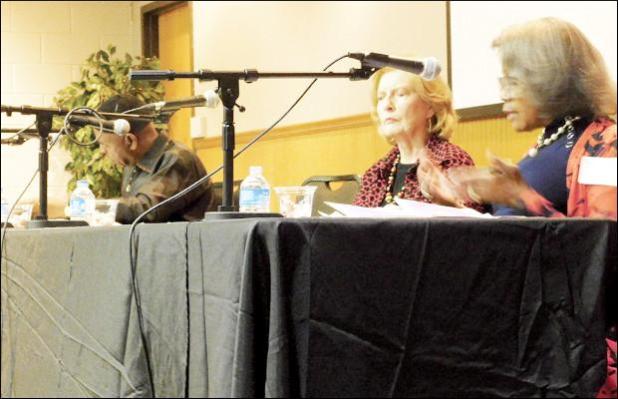
Photo by Sue WatsonPanelists from right, Fannie Lampley, Dr. Margaret Delashmit and Dr. A.J. Stovall present historical narratives relating to the life and work of the late Ida B. Wells, renown human rights activist, journalist and anti-lynching activist born in Holly Springs. Lampley spoke on church and philosophy, Delashmit spoke on the educational climate and Stovall covered the political environment affecting Wells development and course of her life work.
Ida B. Wells formative years
A day-long conference on the life and work of the late Ida B. Wells was held at the McCarty-Varnell BCS Building on Rust College campus, April 16. The conference focused on the 18 years Wells lived in Holly Springs before branching out into her life’s work and passion as a humanist, civil rights activist and journalist.
The morning session consisted of a panel discussion and the afternoon program served as a round table.
In opening remarks, Dr. Wonso Hayes, chair of the Ida B. Wells Commemorative Statute Committee, welcomed guests and provided a short background for the conference.
“It is a delight for the opportunity to see you here today,” she said, adding that she hoped the conferees would learn more about Ida B. Wells, world renown civil rights activist born in Holly Springs.
Wells lived in Holly Springs until age 18 when she moved to Memphis, Tenn., where her life took root as an antilynching advocate.
Dr. Robert Dixon, president of Rust College, presented some reflections, a deep study of Wells and her mission.
“I’m delighted to be here with you and welcome you to this historic institution,” Dixon said.
He said he is quite impressed by the woman, saying many people like to use her name to bring prestige to their efforts.
“She probably would have fit in better in the late 60s, with activists like H. Rap Brown and Stokely Carmichael,” he said.
He said Wells did not find favor with W.E.B. Du Bois, because she was critical of the NAACP (National Association for the Advancement of Colored People) and thought white people were running the organization.
He cited a riot in a small town in Arkansas at the end of World War I, where 12 black men were falsely accused and found guilty of rioting and sentenced to death in what became known as the Arkansas Race Riot.
“They asked her to come to the prison (and pray with them before their death),” Dixon said.
Wells pretended to be a relative of one of the condemned men. She was invited by the men to pray for them and to help them prepare for death.
“Her response to them was, ‘get off your knees. Pray for life to that God you are to pray to, to help you overturn your conviction,’ ” Dixon said.
The Supreme Court overturned the convictions of the men.
Wells, who died in 1931, was definitely a woman of the late 60s, Dixon said.
“She would have had a difference with Martin Luther King because of appeasement,” Dixon said. “Black and White folks thought King was moving too fast. She would have said they went too slow. We (Rust College) need to be the leader.”
Around the country there are Ida B. Wells groups, clubs and societies, he said.
“Anything done in the name of Ida B. Wells ought to have roots here (Rust College),” Dixon said, adding that an Ida B. Wells justice center has been proposed for the Mississippi Industrial College campus. But work to restore the structures on the MI campus will require $70 million and take 50 years, he said, since restoration work and funding is at a trickle of what is needed.
Rust College can establish the justice center in her honor, he said.
“We don’t have to wait,” he said, adding that all Historically Black Colleges and Universities have Ida B. Wells clubs and societies.
He said leadership at these HBCUs would have found it very difficult to tolerate Ida B. Wells.
Dixon said Rust College can do a lot more to bring programs that Wells would embrace.
“That’s a very tall challenge, because it means standing up and speaking out,” he said.
Sharon Goodman-Hill, moderator, recited some of the words of Wells, who she said included that ‘the African American is the backbone of the South.’
“I feel Rust College should celebrate Ida B. Wells just like Ole Miss celebrates William Faulkner,” Goodman-Hill said.
Ida B. Wells was born in Holly Springs in 1862. She is celebrated around the world as a teacher, journalist, civil rights activist and social worker.
Members of the Ida B. Wells Commemorative Statue Committee, many present at the session, include Wonso Hayes, chair; Suzanne Farese, first vice-chair; Gemma Beckley, second vice-chair; James ‘Jim’ Moore, treasurer; Tim Liddy, secretary; Shirley Byers, legal advisor; Lisa Liddy, event chair; Justin Hall, Marshall County; and Patricia Merriweather, Holly Springs.
The conference focused on Wells’ humble beginnings in Holly Springs and educational, political and religious influences on Wells from 1862 to 1880.

